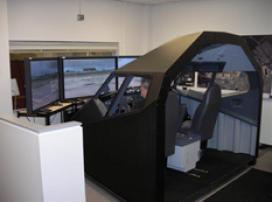Instrument Procedures: Work in Progress
Our current goal is to understand how pilots assess the instrument flight procedure they are planning to fly, taking into account their flight experiences, available flight deck systems, standard operating procedures, and aeronautical chart depictions of the procedure. This effort involved talking with several pilots who fly different types of aircraft to complete different types of operations. We asked small groups of two or three pilots to review the charts and procedures as they would in the flight deck, then asked more detailed questions about the procedures and charts.
We completed data collection for this effort in December, 2014. Our next goal is to use the results of this research to develop recommendations for procedure designers, chart manufacturers, and pilots. We also hope to expand this effort to further understand the needs and complexities from the perspectives of Air Traffic providers. A full report on this study is in preparation. Additional briefings are also planned for increasing awareness among aviation professionals in government and industry.
We previously examined chart formats and the ability to find data from the charts. The research on chart formats explored ways to improve the readability of a chart when there is a lot of data presented in a small space. Our current research on the subjective factors in procedure complexity may also tell about the use of chart information. These studies currently focus on paper representations of the procedure, but have implications for electronic charts as well.
Instrument approaches, arrivals, and departures are within the scope of the research. The needs of all types of professional commercial pilots (e.g., both airline, corporate, and even air taxi operations) are being evaluated. Future research may consider the needs of light general aviation.
Volpe also provides technical assistance to FAA flight deck human factors research program managers. The results of the research efforts from the Volpe Center will be considered in the development of FAA guidelines and information related to new instrument procedures. Volpe has benefited from the input of government and industry subject matter experts in aviation and charting who helped to identify and define these research needs.
Volpe has a fixed-base Boeing-737NG simulator to support this research and other projects. The simulator supports two-crew operations and has functional automation so that procedures on the airport surface and all flight phases can be explored. The simulator also has the capability to interface with auxiliary displays for functions such as Cockpit Display of Traffic Information or Electronic Flight Bag.
Volpe also maintains a library of documents related to this topic, including FAA documents, research reports, and industry articles. Click here to see the list of publicly available materials along with brief summaries and links to the full documents.
Research Plan:
Chandra, D. and Herschler, D. (2012). Human Factors Research Plan for Instrument Procedures, FY12 Version 1.1. Submitted to the Federal Aviation Administration ANG-C1 on 19 June 2012.
View document
Technical Reports:
Chandra, D.C., and Markunas, R. (2017). Line Pilot Perspectives on Complexity of Terminal Instrument Flight Procedures, DOT-VNTSC-FAA-17-06. Cambridge, MA, U.S. DOT Volpe National Transportations Systems Center.
View document
Chandra, D.C., and Grayhem, R. (2013). Evaluation of a Technique to Simplify Area Navigation and Required Navigation Performance Charts. DOT-VNTSC-FAA-13-02. Cambridge, MA, U.S. DOT Volpe National Transportation Systems Center.
View document
Chandra, D. C., Grayhem, R. J. and Butchibabu, A. (2012). Area Navigation and Required Navigation Performance Procedures and Depictions, DOT-VNTSC-FAA-12-10; DOT/FAA/TC-12/8, September 2012.
View document
Conference Papers:
Chandra, D.C., and Markunas, R. (2016). Line Pilot Perspectives on Complexity of Terminal Instrument Flight Procedures. 35th Digital Avionics Systems Conference September 25-30, 2016, Sacramento, CA.
View document
Chandra, D.C., and Grayhem, R.J. (2013). Evaluation of a Technique to Simplify Depictions of Visually Complex Aeronautical Procedures for NextGen. Proceedings of the Human Factors and Ergonomics Society Annual Meeting. September 30 - October 4, 2013, San Diego, CA.
View document
Butchibabu, A., Grayhem, R., Hansman, R.J., and Chandra, D.C. (2012). Evaluating a De-Cluttering Technique for NextGen RNAV and RNP Charts. 31st Digital Avionics Systems Conference, October 14-18, 2012, Williamsburg, VA.
View document
Chandra, D.C., and Grayhem, R.J. (2012). Human Factors Research on Performance-Based Navigation Instrument Procedures for NextGen, 31st Digital Avionics Systems Conference. October 14-18, 2012, Williamsburg, VA.
View document
Butchibabu, A., Midkiff, A., Kendra, A., Hansman, R.J., and Chandra, D.C. (2010). Analysis of Safety Reports Involving Area Navigation and Required Navigation Performance Procedures. Proceedings of the International Conference on Human-Computer Interaction in Aeronautics (HCI-Aero 2010). 3-5 November, Cape Canaveral, FL.
View document

